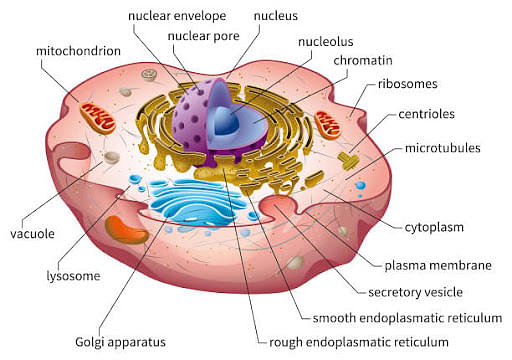Question:
Make a comparison and write down ways in which plant cells are different from animal cells.
Make a comparison and write down ways in which plant cells are different from animal cells.
Updated On: Nov 20, 2023
Hide Solution
Verified By Collegedunia
Solution and Explanation
Comparison of plant cell and animal cell
| Plant Cell | Animal Cell |
|---|---|
| Cell wall is present outside the plasma membrane. Generally regular in shape. | Cell wall is absent. Generally irregular in shape. |
| Plastids are present. | Plastids are absent except in Euglena. |
| A permanent and large vacuole is present. | Vacuoles are many, small and temporary. |
Was this answer helpful?
0
0
Top Questions on What is a Cell Made Up of? What is the Structural Organisation of a Cell?
- Carry out the following osmosis experiment: Take four peeled potato halves and scoos each one out to make potato cups. One of these potato cups should be made from a boiled potato. Put each potato cup in a trough containing water. Now,
- Keep cup A empty
- Put one teaspoon sugar in cup B
- Put one teaspoon salt in cup C
- Put one teaspoon sugar in the boiled potato cup D. Keep these for two hours. Then observe the four potato cups and answer the following:
- Explain why water gathers in the hollowed portion of B and C.
- Why is potato A necessary for this experiment?
- Explain why water does not gather in the hollowed-out portions of A and D.
- CBSE Class IX
- Science
- What is a Cell Made Up of? What is the Structural Organisation of a Cell?
- Which type of cell division is required for growth and repair of body and which type is involved in formation of gametes?
- CBSE Class IX
- Science
- What is a Cell Made Up of? What is the Structural Organisation of a Cell?
- What is osmosis?
- CBSE Class IX
- Science
- What is a Cell Made Up of? What is the Structural Organisation of a Cell?
- How does an Amoeba obtain its food?
- CBSE Class IX
- Science
- What is a Cell Made Up of? What is the Structural Organisation of a Cell?
- Where do the lipids and proteins constituting the cell membrane get synthesized?
- CBSE Class IX
- Science
- What is a Cell Made Up of? What is the Structural Organisation of a Cell?
View More Questions
Questions Asked in CBSE Class IX exam
- The following data on the number of girls (to the nearest ten) per thousand boys in different sections of Indian Society is given below:
Section
Number of girls per thousand boys Scheduled Caste (SC)
940
Scheduled Tribe (ST)
970
Non-SC/ST
920
Backward districts
950
Non-backward districts
920
Rural
930
Urban
910
(i) Represent the information above by a bar graph.
(ii) In the classroom discuss what conclusions can be arrived at from the graph.- CBSE Class IX
- Graphical Representation of Data
- Fig shows the distance-time graph of three objects A, B and C. Study the graph and answer the following questions:

- Which of the three is travelling the fastest?
- Are all three ever at the same point on the road?
- How far has C travelled when B passes A?
- How far has B travelled by the time it passes C?
- CBSE Class IX
- Graphical Representation of Motion
- The text you read is a travelogue where the author, Vikram Seth, talks about his visit to two sacred places in Kathmandu. Imagine that you were with Vikram Seth on his visit to Pashupatinath temple, and you were noting down all that you saw and did there, so that you could write a travelogue later.
Record in point form • what you see when you reach the Pashupatinath temple • what you see happening inside the temple • what you do when inside the temple • what you see outside the temple • what your impressions are about the place.- CBSE Class IX
- Kathmandu
- Sergei says, “I am happy that my words have taken effect.” Why does he say so? Is he right in saying this?
- CBSE Class IX
- The beggar
- In Fig. 9.24, ∠PQR = 100°, where P, Q and R are points on a circle with centre O. Find ∠OPR.

- CBSE Class IX
- Angle Subtended by an Arc of a Circle
View More Questions
Concepts Used:
Cell: The Unit of Life
- A cell is derived as the functional and structural unit of life. Every cell is surrounded by a cell membrane that dissects the external and internal environments of the cell. The interior environment of a cell is called the cytoplasm.
- It carries cellular machinery and structural elements. The nucleus is present in the center of the cell, which includes all the hereditary information of an organism. Some of the molecules present in the cell are protein, carbohydrates, starch, and sugar.
Read More: Fundamental Unit of Life: Cell
Parts of Cell:
The different parts of a cell and their functions are as follows:
- Cell Membrane
- Cell Wall
- Nucleus
- Cytoplasm
